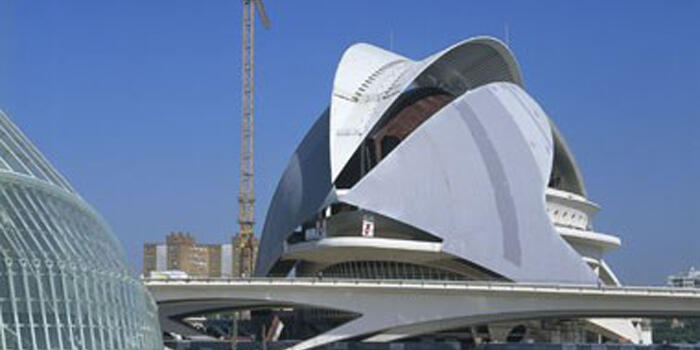The European Prize for Architecture Awards Tell a friend
BACK TO ARCHIVE
The City of Arts and Sciences (No4)
Palacio de las Artes 2003
Location: Valencia, Spain, 1998-2001
Location: Valencia, Spain, 1998-2001
“As the site is close to the sea, and Valencia is so dry, I decided to make water a major element for the whole site using it as a mirror for the architecture.”--Santiago Calatrava
The City of Arts and Sciences, developed by Santiago Calatrava, is a large-scale urban recreation center for culture and science.
Set in the old dried-up river bed of the Turia, midway between the old city of Valencia and the coastal district of Nazaret, the City of Arts and Sciences covers an area of 350,000 square meters.
Following a disastrous flood in 1957, the river was diverted along a canal to the south of the city, and the dried-out riverbed planted as a 7-kilometer long promenade through the center of the city.
L'Hemisfèric (Planetarium) was the first element to be opened to the public in April 1998. The Science Museum Principe Felipe opened in 2000, L'Umbracle (Parking Structure) opened in 2001, the Palacio de las Artes, opened in 2003. Calatrava's use of pure white concrete and Gaudiesque fragments of shattered tiles, an important Valencian industry, tie all the structures together as a whole.
The two principle buildings, the L'Hemisfèric and the The Science Museum Principe Felipe, are organized around a raised promenade running from the base of the Palacio de las Artes along the defining, longitudinal axis of the site, and offering views out towards the sea.
Palacio de las Artes 2003
Conceived as the final element in the City of Arts and Sciences complex, the Valencia Opera House (Palacio de las Artes) has been designed as a series of apparently random volumes, which become unified through their enclosure within two symmetrical, cut-away concrete shells. These forms are crowned by a sweeping steel sheath, which projects axially from the entrance concourse and extends over the uppermost contours of the curvilinear envelope. The resulting structure defines the identity of the Opera House, dramatically enhancing its symbolic and dynamic effect within the landscape, while offering protection to the terraces and facilities beneath.
The different volumes of the building are stacked between horizontal promenade decks, which cantilever off the side of the structure. The fully air-conditioned auditorium, located within the 1300 seat opera house, occupies the central core. This core is set within an acoustically shaped shell embedded within the cluster.
The facilities are connected to a music school situated along the southern periphery of the site, which also houses smaller, individual practice spaces and administration areas.


















